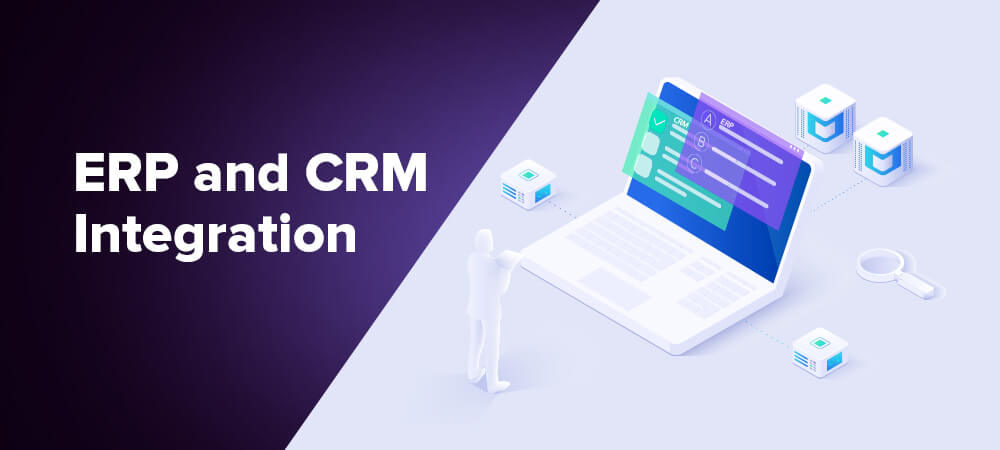Imagine if your sales and operations teams spoke the same language, where customer data and business processes flowed seamlessly?
According to recent findings, integrating CRM and ERP systems can boost customer retention by up to 25%.. Yet, it’s a reality many businesses overlook. Most organizations still run these systems in silos—missing out on the transformative potential of true integration.
When CRM & ERP software work together seamlessly, they don’t just improve efficiency—they unlock entirely new levels of customer insight, accelerate decision-making, and have advantages that are hard to replicate.
Not sure what these CRM ERP integration benefits are? Let’s discuss the main advantages of CRM and ERP integration and how they contribute to the success of your organization. But first, let’s understand how different they are.
CRM vs ERP software
CRM and ERP software are used by businesses to optimize their processes. However, the goal, approach, and anticipated outcomes of both systems are different.
- Accounting, procurement, project management, risk management and compliance, and supply chain operations are just a few of the daily business processes that enterprises can handle with the use of enterprise resource planning (ERP) software.
- CRM (Customer Relationship Management) software allows organizations to define strategies, techniques, and tools for managing, retaining, and acquiring customers. It streamlines all sales and marketing communications, keeps track of interactions with customers, and allows team members to reach out to customers (email, SMS, phone call) via the portal itself.
What is ERP software?
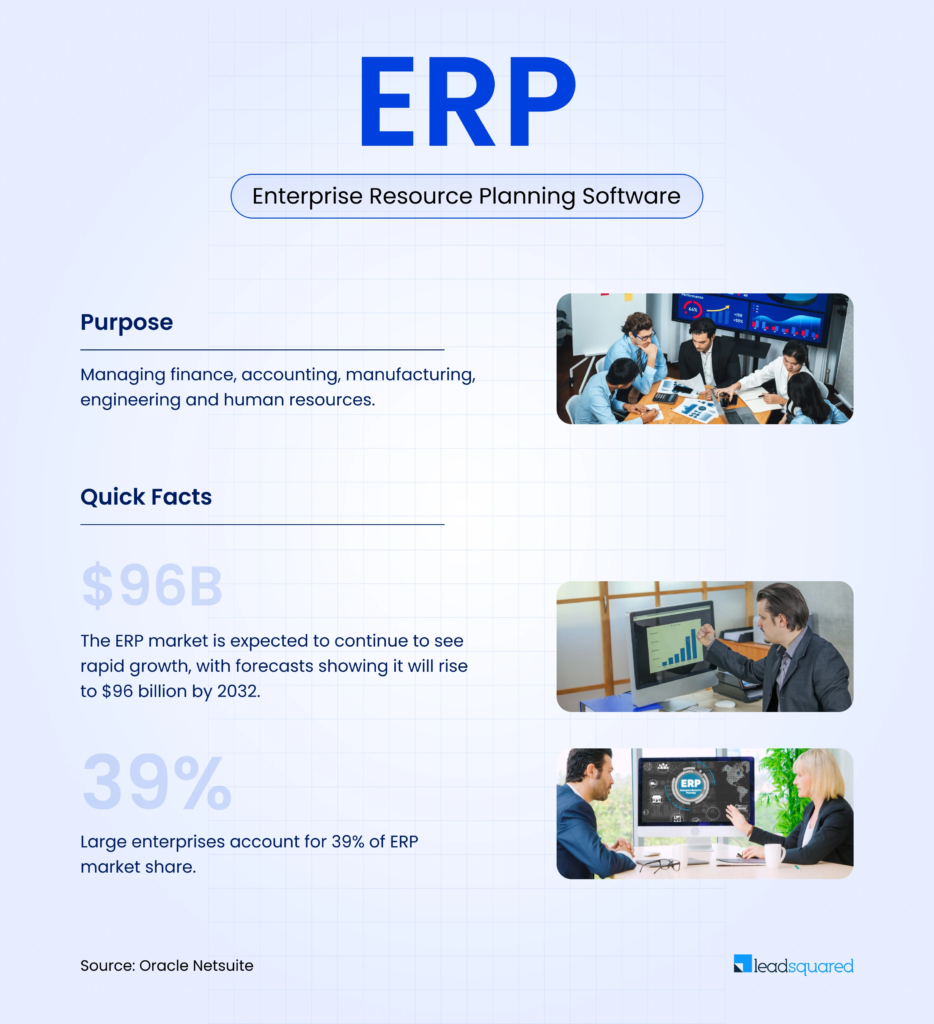
ERP software offers applications that automate and manage every day and back-end processes. The system typically stores shipping and billing information, purchasing history, and financial data. It may also store company inventory data and accounting information. In the end, ERP helps reduce manual labor, optimize, and centralize operations.
Ultimately, the information it tracks drives effective decision-making processes and streamlines operations. Top ERP examples include Oracle ERP Cloud, Biz Automation, SAP S/4 HANA, and Oracle NetSuite.
What is CRM software?
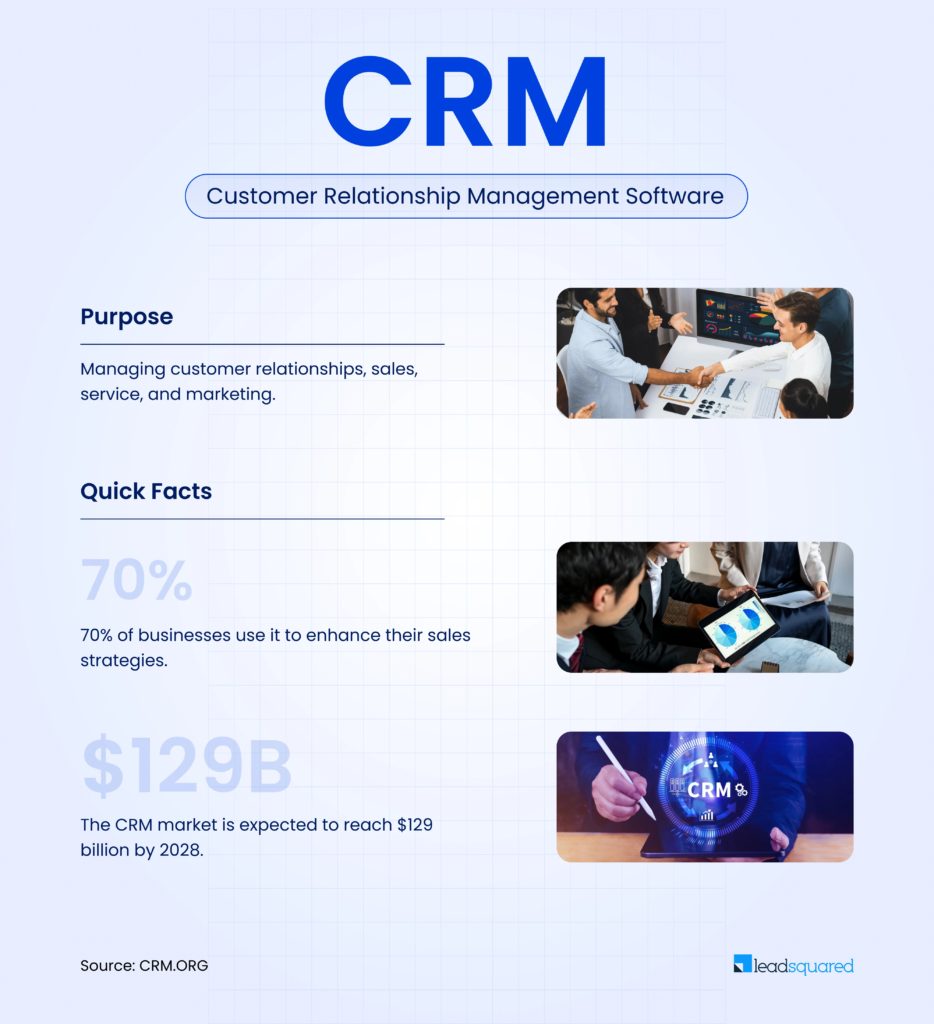
CCRM is a business software that helps you maintain good relationships with customers. It stores data about the customer, such as contact information and interaction history. This data can help nurture relationships and drive profitability and growth. In the end, CRM has two core goals:
- To provide a unified experience to the customer.
- To deliver a seamless customer experience.
Nonetheless, even as both ERP and CRM may store similar information. ERP software concerns back-end processes, while CRM focuses on the front-end.
Therefore, CRM helps the company track, automate, optimize, and analyze customer interactions. It unifies sales tracking, generating leads, pipeline management, marketing, and customer communication. Top CRM software examples include LeadSquared, Zoho, Freshsales, HubSpot, and Microsoft Dynamics.
Why modern businesses outgrow legacy systems
As businesses evolve, the limitations of legacy ERP and CRM systems become more pronounced. These older systems store information locally, lack cloud connectivity, and often operate in isolation from one another. This fragmented approach can quickly become a roadblock as your company grows or adapts to new market demands.
Think of it like clinging to your old flip phone while everyone else is messaging, video calling, and collaborating through smartphones. Sure, it technically works—but you’re missing out on features that your competitors are leveraging right now.
Here’s why it’s increasingly critical for organizations to step away from legacy systems:
- Manual processes and slow updates: Legacy tools usually require manual data entry and frequent updates for every minor change, eating up valuable time and opening the door to errors. If different systems aren’t communicating, your team risks duplicating work and missing key insights.
- Reduced visibility: Siloed information makes it hard to get a complete view of operations. If sales, inventory, and financial data live in separate worlds, you’re forced to piece together the puzzle manually, which slows decision-making and exposes you to risk.
- Limited agility and scalability: As your business expands, legacy platforms can become a bottleneck. They don’t scale easily and need extensive, costly maintenance to keep up with new requirements—making them less suitable for fast-paced, modern markets.
- Missed opportunities: With the rapid shift toward online sales and digital customer interactions, legacy systems often can’t keep pace. This can mean missed orders, fewer upselling and cross-selling opportunities, and overall less efficiency compared to competitors using modern cloud solutions.
Many organizations are now prioritizing a move to integrated, cloud-based platforms that offer a unified view of data—enabling smarter, faster decisions and effortless collaboration.
Seamless CRM ERP integration means less time jumping between systems and more time focused on your core goals. By modernizing your stack, you set your team up for agility, growth, and a much-needed competitive edge.
Now, let’s discuss the advantages of ERP and CRM integration and how it can benefit you.
Benefits of ERP and CRM integration
Together, CRM and ERP can bring tremendous potential to any business. Otherwise, your organization will have disjointed information silos, which is dangerous.
Incorrect handling of customer information increases the risk of dissatisfaction and loss of trust. That’s why it’s crucial to unify your entire sales and operations process while building profitable customer relationships.
ERP systems boost order-to-shipment times by 23% and inventory accuracy by 97%, according to statistics. Still, CRM helps you create personalized interactions that foster loyalty and better marketing ROI. So, your business can offer great experience with the CRM ERP system working together. Ultimately, it will drive customer retention and loyalty.
1. 360-degree view of customers
CRM and ERP integration offers a unified view of your customers. It is perhaps the biggest reason you need it.
You may have a comprehensive picture of your clients when you combine ERP and CRM solutions. It provides complete insight and accuracy across accounting, finance, sales, and support. It helps in improving your understanding of your clientele. In this manner, you may effectively monitor your consumer preferences, profitability, and loyalty. Additionally, you can find possibilities to upsell and cross-sell to current clients. It will assist you in determining future growth possibilities and putting better tactics into practice.
2. Consistent information
Both ERP and CRM systems manage the same customer information, which can lead to data duplication if they aren’t properly integrated. The issue arises when each system operates independently. Without this connection, teams risk working with inaccurate customer and purchase data. When you manage two separate systems, every change (like updating contact details or order status) must be entered manually in both platforms. Ideally, any update made in the ERP system should automatically sync with the CRM system, and vice versa. This ensures consistent, real-time data across departments, improving collaboration and customer experience.
When your CRM and ERP platforms work together, duplicate data becomes a thing of the past. You can now look forward to real-time, up to date, and accurate stores of information. Your integrated platform can also help deal with inaccurate data. In turn, your business enjoys better data-driven processes and results.
3. Better employee collaboration
A connected and integrated workforce enjoys the benefits of CRM in ERP through higher productivity and efficiency. They can push for more results because everyone is on the same page.
Before now, each team had a different set of similar data. So, accessing the right information at any given time was almost impossible.
Your team can share and use up-to-the-minute information when ERP and CRM work together. It improves their chances of achieving better and more effective results.
4. Increased mobility with ERP and CRM integration
Real-time data helps the sales and operations team deal with customer contracts efficiently. It helps them hasten contract approval processes and even achieve same day signing.
Thus, a centralized system will help shorten crucial process cycles. Cloud-based CRMs also make it easy to access information and update tasks from any location. It boosts faster time-to-revenue and maximizes business opportunities.
5. Reduced training and IT overheads
Statistics show that businesses spend an average of 31.5 hours and $1,208 per employee every year on training. A single, unified CRM and ERP platform can significantly reduce that investment — because your teams only need to learn one system instead of juggling two.
With consistent interfaces, shared data, and unified workflows, employees pick up skills faster and spend less time switching between tools. Training becomes simpler, more focused, and directly relevant to their day-to-day work — which makes it easier to adopt and apply immediately.
6. Improved efficiency
Siloed systems mean you might be spending time on manual, arduous tasks unnecessarily. Integration of CRM with ERP makes it easier to automate workflows and manage processes.
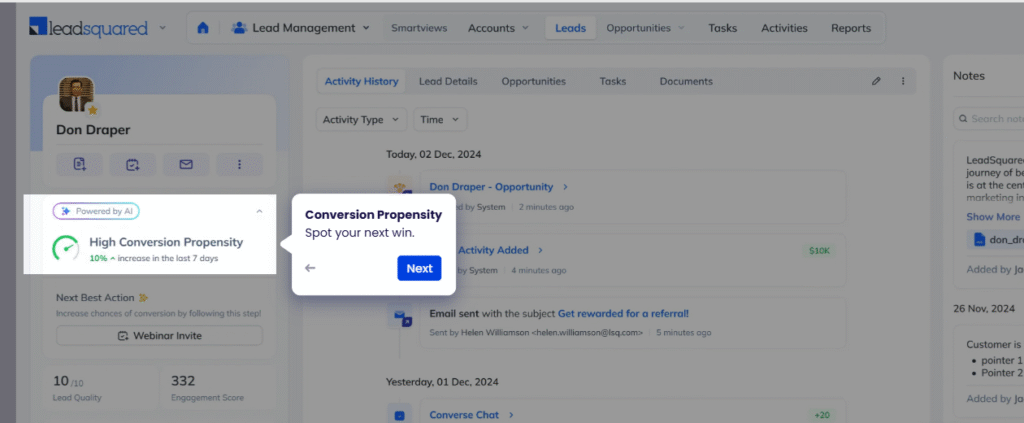
That way, your teams can let go of manual, tedious tasks that chew up valuable time and resources. They can spend more time on crucial processes that impact your bottom line. They can also enter transactions, or update information at the touch of a button. Ultimately, the integration of CRM & ERP saves your company time and money in labor costs. It reduces data redundancy, thereby making life easier for you and your teams.
7. Boost customer relationships
Real-time information helps your team interact with customers actively. It will also help you anticipate your customer needs and reduce support service time. In turn, your customers will enjoy a better experience.
The result is higher customer satisfaction, which drives repeat sales and customer retention. Over time, you can build communities of loyal customers saying good things about your brand. It translates to better visibility, more growth, and sustainable success.
8. Accurate predictions
A fully integrated system makes it easier to deliver a great customer experience. Imagine a customer contacting your service desk for an order update. If your service representative has to navigate multiple disconnected systems to find that information—some of which may contain outdated or inaccurate data—it slows down response time and creates frustration. Without integration, teams risk working with inaccurate customer and purchase data. The result is a poor customer experience and, ultimately, a potential loss of trust and revenue.
With a fully integrated system, you can boost communication within and outside your company. You can also make better forecasts about the future. It can also help your CRM team deliver accurate quotes and marketing campaigns.
Your ERP team will also help you anticipate product demand. They will also make better predictions about shipping dates. Overall, you can make critical business decisions and mitigate business risks.
The challenge of integrating legacy ERP and CRM systems
Integrating legacy ERP and CRM systems can quickly turn into a massive headache if you aren’t careful. Unlike many modern solutions, older systems typically aren’t cloud-based. Instead, they store data in isolated, on-premise silos. This separation makes it hard to get your valuable business data flowing smoothly from one system to another.
If your setup relies on disconnected legacy software, you’ll need to create and maintain both the applications and the interfaces that connect them—a time-consuming task. Every time you update one system, those connections may need to be rebuilt or reconfigured. Each upgrade risks breaking your integrations, leading to workflow bottlenecks and productivity slowdowns.
And it doesn’t stop there. Legacy systems often require manual entry of the same data in multiple places. Imagine having to update customer information in several systems just to keep things in sync. With each system running on its own rules and databases, you end up with scattered, duplicated, or outdated information—never a recipe for success.
When old software can’t keep up, you miss out on opportunities. Sales orders might slip through the cracks, support tickets could get delayed, and cross-selling becomes guesswork at best. As your business grows and processes evolve, these systems start to feel like you’re dragging around a ball and chain. Scalability suffers, and maintenance eats up time and money.
Let’s not forget about insight and visibility. With siloed systems, seeing the whole business picture is a challenge. Teams waste time searching for up-to-date numbers or making critical decisions based on patchy, unreliable data. If you can’t spot bottlenecks or inefficiencies as they arise, you’re more likely to run into costly surprises down the road.
All these factors combine to make integrating legacy ERP and CRM systems a complicated and resource-intensive process—one that can easily hinder your team’s productivity and customer experience.
Why go native (and cloud-based) with CRM and ERP integration?
The vision for CRM to ERP integration goes beyond just connecting two systems—it’s about creating a single, seamless digital heartbeat for your business. This is where native, cloud-based CRM ERP integration solutions come into play, and why they deserve a closer look.
1. Unified experience and data
A native, cloud-based platform is designed from the ground up for both CRM and ERP functionalities to “speak the same language.” No more jumping between mismatched dashboards or fighting with clunky third-party connectors. Since all modules share the same data model, your teams—from sales to fulfillment—benefit from one reliable source of truth. This eliminates double entry, reduces errors, and means everyone’s looking at up-to-date information, all of the time.
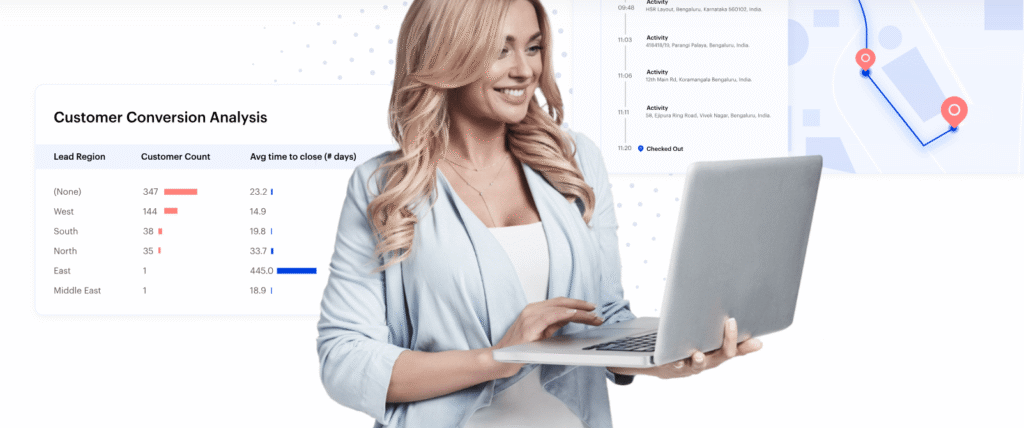
2. Flexibility and scalability on demand
Gone are the days of installing software in a dusty server room or planning disruptive updates. With a cloud-native setup, your business can scale effortlessly—adding new users, automating processes, or launching new features—without the headaches of physical upgrades. Automatic cloud updates mean you’re always running the latest version, with new tools and security enhancements delivered right to your dashboard.
3. Instant accessibility, anywhere
Native cloud solutions empower your team to work from anywhere—be it a client’s office, your home workspace, or on the go. All you need is an internet connection, and your full suite of business tools is at your fingertips. This uniform accessibility not only saves time but also enables faster decision-making and more responsive customer service.
4. Robust security and reliability
Reputable cloud platforms invest heavily in cutting-edge security. This means data encryption, regular backups, and rigorous compliance standards are built-in, giving you greater peace of mind than most on-premises solutions ever could. Your customer and financial data stays protected, no matter where your team is working.
5. A foundation for growth
Choosing a native, cloud-based CRM and ERP solution lays the groundwork for innovation. Integrating with third-party apps, embracing automation, or experimenting with AI-driven analytics becomes much simpler and faster—without the bottlenecks of legacy infrastructure.
Pulling all these advantages together, adopting a native, cloud-based approach isn’t just about smoother integration of CRM with ERP system. It’s about future-proofing your operations so you can deliver a better customer experience and grow without roadblocks.
With these ERP CRM integration benefits in mind, let’s explore one of the most significant outcomes: a truly unified, 360-degree view of every customer interaction.
Concluding thoughts
CRM and ERP integration can drive business efficiency and grow your customer base. Still, your business is unique and different. So, you might need some customization.
Assess your systems, clean up your data, and figure out how you will integrate. Ultimately, you can find the right integration that supports your current and future needs.
Are you looking for a CRM that drives high-velocity sales and integrates with ERP, telephony, and several other useful systems?
Try LeadSquared CRM today!
ERP and CRM integration FAQs
What is ERP and CRM?
ERP is a software system for Enterprise Resource Planning. It allows for storing and sharing information in a standardized format across teams and other integrated software systems. Customer Relationship Management (CRM) software is the best solution for managing a company’s interactions with existing and potential customers.
How do ERP and CRM work together?
With an integrated CRM and ERP system, both sales and manufacturers/retailers can enter transactions (product or sales orders) or change customer records. It allows all the teams to have the actual and updated information every time.
What is CRM integration?
CRM integration refers to the capabilities of the CRM software to integrate with other software systems, such as telephony, email, chat, social media, and other software tools.
What is ERP integration?
ERP integration refers to the capabilities of the ERP software to integrate with other software systems that a company might be using. For example, it may connect with CRM software, billing, payroll software, etc.
Stock visibility in CRM from ERP — What to sync for order promise?
For accurate order promises, your CRM to ERP integration should sync real-time inventory levels, warehouse locations, available-to-promise (ATP) quantities, lead times, and backorder status. This ensures sales teams can confidently commit to delivery dates based on actual stock visibility from your ERP system, reducing order cancellations, and improving customer trust.
What data points are synced through CRM and ERP integration?
A robust CRM ERP integration architecture ensures that critical business data is kept consistent across the organization. Some of the essential data points that benefit from synchronization include:
Client and account information
Customer contact and profile details
Product information, including item descriptions and SKUs
Pricing, discounts, and promotional offers
Sales orders, purchase history, and transaction records
Payment status and financial information
By keeping these data points unified, your teams can access real-time, accurate information—no matter which system they’re using. This consistency eliminates the confusion of outdated or mismatched records, streamlines workflow, and empowers every department with up-to-date insights.





